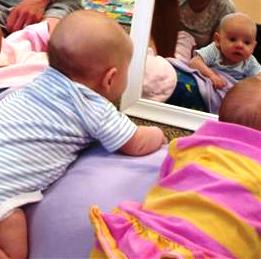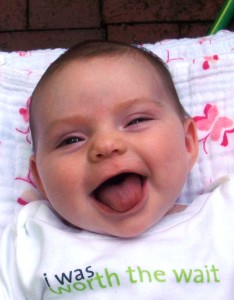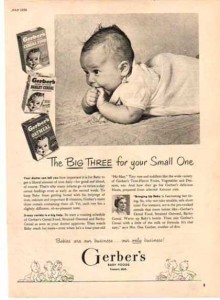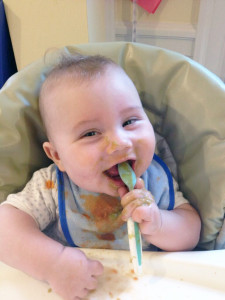Does your baby have a flat spot on the back of his head? Many babies do. Fortunately, most flat spots, called Positional Plagiocephaly, are mild and need no treatment other than positioning changes and monitoring. Learn how to prevent and treat flattening of your baby’s head, and when to speak with your pediatrician about concerns.
What is Deformational Plagiocephaly or “Flat Head”?
Also called Positional Plagiocephaly, Deformational Plagio refers to the misshapen or asymmetric shape of the head. The flat spot is usually on the back of the baby’s head, though in some cases, for example, with torticollis, the flat area may be on one side of the skull.
What causes deformational plagiocephaly or “Flat Head”?
The most common cause of deformational plagiocephaly is positional. A newborn’s skull is soft and designed to grow quickly. When babies rest in one position for long periods of time, the skull begins to flatten from the external pressure against it. Since babies can spend a lot of time in the “passive recline position” (car seats, bouncer seats, swings, back-to-sleep position), it’s possible for a flat area to develop. Once a flattening occurs, it’s easier for the head to “resettle” there each time, allowing other parts of the skull to grow but not the flat area.
Shifting your newborn’s sleeping and resting positions is the best prevention for developing a flat spot. During diaper changes and for sleep, try alternating his “head and feet” position, reversing the way you usually lay your baby on his back. When your baby is awake and observed, use more tummy time and side-lying positions. Lots of awake tummy time with encouragement will also help by strengthening the neck, shoulder and arm muscles, which will eventually help your baby shift his own positions. Carrying, holding or “wearing” your baby without pressure on the back of his head will also encourage muscle development and prevents pressure against the flat spot.
Is a Bald Spot or stripe on the back of the head cause for concern?
No. It’s common for babies between 4 – 7 months to “wear away” an area of hair from turning their head side to side when in car seats, bouncer seats or sleeping on the back. This bald patch is normal and if not accompanied by significant skull flattening, is not a cause for worry. Bald patches tend to resolve between 9 to 12 months, as your baby will be sitting, crawling and moving more, spending less time on his back, allowing hair time to fill in again. Many fashionable babies sport a fine mullet.
Torticollis and Flat Head –
A common cause of deformational plagiocephaly is muscular torticollis. Muscular torticollis (sometimes called “wry neck”) is a tightening of specific neck muscles, which prevent full motion and keep the baby’s head slightly tilted or turned to the side. Because torticollis causes the baby to keep his head at a specific angle, a flat spot may form as the baby’s head rests against the mattress or seat at the same position for repeated periods of time, leading to positional plagiocephaly.
Torticollis is often missed by parents and health care providers, since newborns have short necks and tend to lean or “slump” to one or another side. Make sure your baby is an “equal opportunity slumper” – sometimes leaning to the right side and other times the left, when sleeping, and check that your baby can turn his head equally to both sides. If you’re concerned about your baby’s persistent head-tilt or suspect restricted neck motion, speak to your pediatrician.
Treating Torticollis – for a baby with torticollis, treating the tightened muscles early is important to achieve full head movement as baby grows. Full motion of the head and neck helps with balance as well as the physical appearance of the head shape (and sometimes facial symmetry). Torticollis is best treated early, during your baby’s first several months of life when specific stretching and repositioning techniques are most effective. Your pediatrician may refer you to a pediatric physical therapist to learn specific stretching exercises and positioning tips for your baby’s particular needs.
What about Helmets?
Maybe you’ve seen a baby out in the store or mall wearing what seems like an infant-sized football helmet. This is a therapeutic device called a Cranial Band or Orthotic, worn to help correct a misshaped head. In more severe Plagio, when flattening or asymmetry is significant and beginning to affect facial appearance (one eye or ear may begin to move out of line with the face), or, in situations where a baby was born very prematurely or has early closure of the skull bones, an Orthotic may be recommended. Made by a specialist, baby helmets are very lightweight, with a hard outer shell and foam lining. Very gentle pressure restricts growth in some areas while allowing the skull to “fill out” and freely grow around the flattened areas, rounding out the head. Helmet therapy typically takes 3 to 6 months with good results. Babies generally adjust to wearing a helmet quickly – it’s harder on the parents usually due to comments from well-meaning strangers and additional appointments. But remember that mild flattening is common and usually doesn’t require treatment with a helmet.






